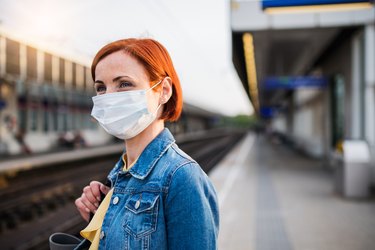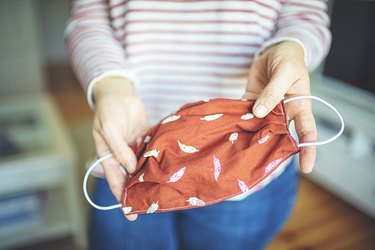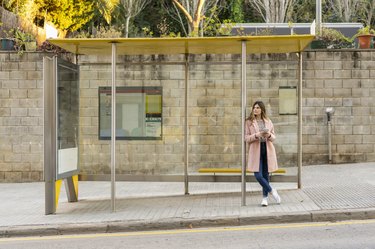
With several COVID-19 vaccines readily available, states and businesses are reopening. And, as millions of people return to worksites, lots will undoubtedly rely on public transit to get there. If you're among them, you probably have concerns about how to avoid picking up germs on your route.
When it comes to the novel coronavirus, your best strategy is to get vaccinated. You can look for a nearby appointment to get your shot on Vaccines.gov.
Video of the Day
Video of the Day
But of course, even before the novel coronavirus, trains, buses and other forms of public transportation were filled with people — and their germs. And because public transportation is crowded and involves prolonged close contact with others, masks are still required, even for people who are fully vaccinated, according to guidelines from the Centers for Disease Control and Prevention (CDC).
Whether or not you're fully vaccinated, here are 11 strategies from experts to help you avoid germs and stay safe on your commute.
Get tips on how to stay healthy, safe and sane during the novel coronavirus pandemic.
1. Pay Before You Ride
If you're traveling by train or bus, use transport that has contactless payment, says David Freedman, MD, a professor emeritus of infectious diseases at the University of Alabama at Birmingham.
Through contactless payment like tap-and-go cards or pay-in-advance methods via smartphone apps, you can purchase your ride quickly and avoid contact with station agents and drivers to potentially reduce transmission of the virus.
Though it may be challenging aboard a bus or train, do your best to practice social distancing to the greatest extent, Dr. Freedman says. And not only during the ride, but while waiting on platforms or at bus stops and entering and exiting the vehicle or station.
"These doors are choke points," Dr. Freedman says, meaning that they can become easily crowded, congested or blocked with hoards of commuters in a hurry. The last thing you want is to be elbow to elbow with someone who may be infected.
That's why it's essential to maintain at least six feet of distance at all times, per the CDC guidelines. Indeed, a May 2020 study in Health Affairs found that places without social distancing exhibited 35 times greater the risk of spreading the coronavirus.
Related Reading
3. Use the Rear Exit
One simple way to safely socially distance is to avoid interactions with bus drivers by exiting or entering the vehicle through the rear doors. Drivers, who encounter commuters all day are the most likely people on the vehicle to be infected, says Dr. Freedman, who recommends following the six-feet-apart rule with bus (and train) operators at all times.
4. Wear a Mask

Whenever you're out and about on public transit, wear a mask and avoid touching your eyes, nose and mouth, Elizabeth Scott, PhD, associate dean and professor of biology at Simmons University and an expert in home and community hygiene, tells LIVESTRONG.com. She also recommends sporting glasses or goggles to reduce the impulse to touch your peepers. By doing so, you help lower your risk of the virus reaching them via droplets and aerosols.
Masking up is required for everyone on public transport — that includes people who are fully vaccinated, per CDC guidelines.
5. Stay Put
With the exception of moving to a new seat to avoid someone who's clearly sick or not wearing a mask, Dr. Freedman says you should aim to stay in one place during your ride to minimize the contact you have with people.
This goes back to the idea of social distancing: The fewer encounters you have with potentially ill individuals, the better.
And it goes both ways. If you're a COVID-19 carrier and you don't know it, you don't want to be accidentally shedding the virus all over the subway or train. As a matter of fact, an April 2020 study in Nature Medicine estimated that 44 percent of infections occur due to pre-symptomatic people, aka those who have yet to show symptoms.
6. Slather on the Hand Sanitizer
Using an alcohol-based hand sanitizer after riding on a train or bus sounds like a no-brainer. But did you know that you should also squirt some sanitizer into your hands as soon as you get on public trans too?
"This way, you reduce the risk of both contaminating surfaces as well as picking up contamination," Scott says.
Remember, we must all take responsibility for staying safe and stopping the spread of this deadly virus among our communities. That means doing what's necessary to prevent others from picking up your germs.
This is especially essential if you're infected with COVID-19 but don't exhibit any signs. In fact, it can take anywhere from five days to two weeks for your symptoms to develop, according to a May 2020 study in the Annals of Internal Medicine.
In the meantime, as the virus incubates, you can be inadvertently passing on your pathogens to other people on public transit. Even asymptomatic individuals who never exhibit indicators of illness may still spread the coronavirus.
If you don't have hand sanitizer, try to touch as few things as possible during your commute and wash your hands with soap and water for at least 20 seconds as soon as you can.
7. Try Not to Touch Anything
Whether you have hand sanitizer or not, steering clear of surfaces on the subway or train is a safe strategy in general. That's because the novel coronavirus may last on various surfaces anywhere from a few hours to several days, per the CDC.
"If possible, don't touch anything, including the seat itself," says Dr. Freedman.
That said, the risk of getting COVID-19 from touching a surface is low, according to the CDC. Studies indicate that the risk of getting infected with SARS-CoV-2 (the virus that causes COVID_19) may be less than one in 10,000, per the CDC.
Still, avoiding frequently touched surfaces — where any number of germs can linger — is a good practice for avoiding catching a cold and other illnesses.
8. Pick Off-Peak Hours

If you have some leeway in your schedule, try to avoid riding on public transportation during peak hours, Scott says. By tweaking your travel hours, you can dodge the times when trains and buses are busiest.
Never cram yourself into a crowded vehicle and always give yourself extra travel time in case you need to wait for a less-packed train or bus.
9. Avoid Conversations
While it's always important to be considerate and courteous with your fellow commuters, skip small talk on your daily travels. "Don't let a stranger (or anyone really) engage you in conversation," Dr. Freedman says.
That's because COVID-19 can be spread through respiratory droplets not only when a sick person coughs or sneezes but simply when they talk, per the CDC. And, since infected individuals may not show symptoms, it's hard to tell who's carrying the coronavirus in the first place.
In fact, small respiratory droplets produced by regular speech can linger in the air for at least eight minutes, according to a May 2020 study in PNAS. These findings appear to show that normal speaking can easily transmit the coronavirus, especially in confined environments with poor air circulation like trains and buses.
10. Nix the Noshing
On a busy day, you might use your commute time to sneak in a snack. But in the age of the novel coronavirus pandemic, eating on-the-move isn't a smart idea, says Dr. Freedman.
For one thing, you must remove your mask to have a quick bite. Again, a face covering not only helps to protect you from pesky pathogens, but also keeps your germs from flying freely into the air and infecting other passengers.
Plus, odds are, no matter how diligent you are about keeping your hands to yourself, you've probably touched a soiled surface at some point during your ride.
Though there's no evidence you can catch coronavirus from contaminated food, it's still not advisable to put your hands near your mouth in public. That's because, sans mask, you're likely to touch your face, too, and if you have any microbes on your mitts, they can make their way into other entry points of infection, including your nose and eyes.
The same rule goes for drinks too, Scott says. Leave your water bottle in your bag — otherwise the germs you picked up on public transit may hitch a ride and infect you later.
11. Use Another Mode of Transportation
If you have another way to travel, use it. "I think it's a good idea to avoid public transport if possible and allow people who have no other choice to commute more safely," Scott says.
We must all do our part to stay safe and protect others. That means if commuting by train or bus isn't absolutely essential, don't do it.
"Infection prevention is a shared responsibility," says Scott.
Whenever possible, walk or bike to work (but if you are using a bike-sharing service, wipe down the seat and handlebars with a disinfectant and use hand sanitizer before and after). Not only will you lower your risk of contracting or spreading the coronavirus, but you'll also log some hours of heart-healthy exercise and possibly improve your mental health.
In fact, walkers who stroll through green spaces on their way to the office can reduce stress and boost their mood, according to a December 2018 study in Environment International. What's more, cyclists who commute to work have a lower risk for cardiovascular disease and cancer, per an April 2017 study in the BMJ.
Concerned About COVID-19?
Read more stories to help you navigate the novel coronavirus pandemic:
- BMJ: “Association between active commuting and incident cardiovascular disease, cancer, and mortality: prospective cohort study.”
- Environment International: “Active Commuting Through Natural Environments Is Associated With Better Mental Health: Results From the PHENOTYPE Project.”
- Centers for Disease Control and Prevention: “How COVID-19 Spreads.”
- Health Affairs: “Strong Social Distancing Measures In The United States Reduced The COVID-19 Growth Rate.”
- Annals of Internal Medicine: “The Incubation Period of Coronavirus Disease 2019 (COVID-19) From Publicly Reported Confirmed Cases: Estimation and Application.”
- Centers for Disease Control and Prevention: “Cleaning and Disinfection for Households.”
- PNAS: “The airborne lifetime of small speech droplets and their potential importance in SARS-CoV-2 transmission.”
- Nature Medicine: “Temporal dynamics in viral shedding and transmissibility of COVID-19.”
- Vaccines.gov: "Find COVID-19 Vaccines Near You"
- Centers for Disease Control and Prevention: "Requirement for Face Masks on Public Transportation Conveyances and at Transportation Hubs"
- CDC: "Science Brief: SARS-CoV-2 and Surface (Fomite) Transmission for Indoor Community Environments"
Is this an emergency? If you are experiencing serious medical symptoms, please see the National Library of Medicine’s list of signs you need emergency medical attention or call 911.